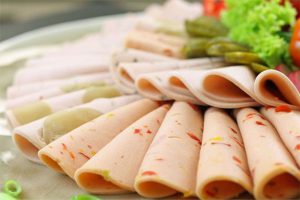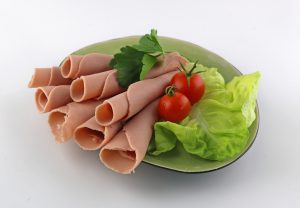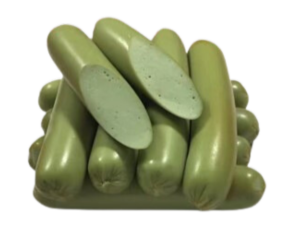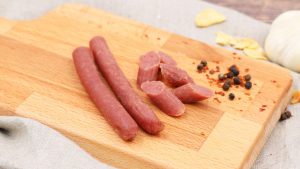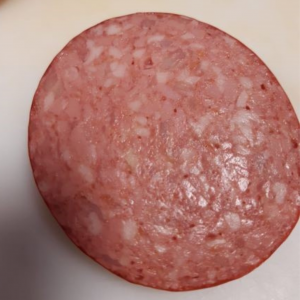In its simplest form the word ‘curing’ means ‘saving’ or ‘preserving’ meat and the definition covers preservation processes such as: drying, salting and smoking. When this term is applied to products made commercially it will mean that meats are prepared with salt, nitrite, ascorbates, erythorbates and with possible more ingredients that are pumped into the meat. Meat cured only with salt, will have a better flavour but will also develop an objectionable dark colour. Factors that influence curing:
- The size of the meat – the larger meat the longer curing time.
- Temperature – higher temperature, faster curing. – link
- Moisture content of the meat.
- Salt concentration of dry mixture or wet curing solution-higher salt concentration, faster curing.
- Amount of fat-more fat in meat, slower curing.
- pH – a measure of the acid or alkaline level of the meat. (Lower pH-faster curing).
- The amount of Nitrate and reducing bacteria present in the meat.
Curing Temperatures
The curing temperature should be between 2-5° C. Lower than 2° C temperature may slow down the curing process or even halt it.
There is a temperature that cannot be crossed when curing and this is when meat freezes at -2° C.
Higher than normal temperatures speed up the curing process but increase the possibility of spoilage. This is a balancing act where we walk a line between the cure and the bacteria that want to spoil meat. The temperature of 10° C is the point that separates two forces: below that temperature we keep bacteria in check, above 10° C bacteria forces win and start spoiling the meat.
Curing methods
There are many methods of curing meat, depending on the piece of meat and the intended product. A distinction is made between
– classic curing methods
– industrial curing methods
Classic Curing Methods
The origins of meat preservation are lost to the ages but began when humans began to realize the preservative value of salt. Sausage making originally developed to preserve and transport meat. The procedure of stuffing meat into casings remains the same today, but sausage recipes have been refined and sausage making has become a highly respected culinary art
There are three traditional methods of curing meats:
- Dry curing | Salt curing
- Wet curing
- Combination curing
Dry curing: The most traditional dry curing method involves submerging a piece of meat in a container of salt for an extended period. Moisture leeches out of the meat during the salting process, preserving the ingredient while cultivating an intensely savoury flavour. This process is used for making pancetta, prosciutto, and bresaola
Wet curing, also known as brine curing is like pickling. It involves curing the meat with the help of a salt and water solution (also known as brine). There are two options for brine curing. The first is to fully submerge the meat in the brine (with an object on top to keep it weighed down) and place it in the refrigerator to cure. The second is to inject the curing solution into the meat using a meat pump before cooking the meat.
Combination curing: This combination of dry curing and brine curing involves injecting the meat with a curing solution before adding a dry rub to the surface and storing the meat in the refrigerator. This method can prevent spoilage, as curing occurs on and beneath the meat’s surface.
Industrial Curing Methods
Meat plants cannot afford the luxury of the traditional wet curing as it requires storage space and extra time. The process they employed consists of pumping meats with multi needle injectors with, then massaging the meats in tumblers to distribute the curing solution more evenly. Needle injectors pump the meat under pressure with a prepared solution that contains everything that is allowed by law to make the process the shortest and most economical. Some methods allow pumping meat with a curing solution and microscopic parts of meat of any kind. Massaging is an additional curing step employed by industrial production plants. It involves placing pieces of meat that are pumped with curing solution into a meat tumbler. This is a machine with a rotating drum and the meat pieces will be bouncing around its mowing walls providing even better brine distribution inside of the meat. The meat does not have to be immersed in brine at all. Using high production stitch pumping machines and a tumbler, a ham can be ready for the smoker in 24 hours. You can massage your meat by hitting it with a closed fist all around, you could even wrap up meat with a towel and hit it for a few minutes with a heavy object. You could also buy a small capacity tumbler machine.
The tumbler helps to distribute the solution evenly inside, but nitrite needs time to create a pink colour. Salt also needs time to cure meat but there is no easy way to notice how well salt did its job. If curing time is too short, some areas of the large piece of meat will turn grey, some lightly pink and some will be red pink. That is why we use cure accelerators so they can cure and colour meat at a much faster rate.
Injection mixes
An injection mix, also known as a brine, can be injected into meat by means of a multi-needle injector which inserts the brine under pressure. The purpose of this method is to obtain a rapid and even distribution of the salt and other ingredients into the product.
Injection mixes are developed to suit the needs of individual customers about functionality, including yield, protein content, cooking yield, drip loss, ingredient declaration, taste, tenderizing effect and colour.
Tumbling mixes
After a piece of meat or fish has been injected with brine, the further distribution of the brine can be facilitated by massaging or tumbling the product. During the tumbling process, the brine is evenly distributed, and the meat proteins are released from the product. To provide even more functionality, a tumbling mix can be added. The optimum result can be achieved by balancing the distribution of brine by means of maximum diffusion whilst minimizing damage to the muscle parts.
Small pieces of meat will not be injected but tumbled. Tumbling is best done by specialist tumbler and tumbling mix that guarantee easy and fast absorption, yield and stability.
Industrial curing equipment
Today, curing is done with curing accelerators, injectors and meat tumblers in order to save time, space and ultimately the money. To shorten curing time we have to introduce curing accelerators, flavour and colour enhancers. The products look pretty and are packed nicely.
Machines to produce cooked ham:
Brine preparation
Multi needle injector
Tenderizer
Massagers/tumblers
Basic characteristics of multi needle injectors:
-Boneless meat as well as bone-in meat injectors
-Waking beam conveyor
-Centrifugal brine-pump
-Mechanical drive
-Air-spring needle head for bone in products
-multi needles
-Bed width
-Variety of needles:
Outside diam. Inside diam. Injection area Specific details
4,0 mm 2,0 mm 10-50 % standard
4,0 mm 2,0 mm 20-90 % large output opening
3,0 mm 1,5 mm 06-25 % standard
3,0 mm 1,5 mm 10-45 % large output opening
2,2 mm 1,5 mm side outlet holes
1,5 mm 1,0 mm hypodermic
The needles with a large output opening are more suitable for dense brines.

